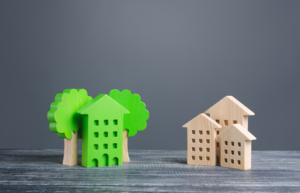Energy efficiency isn’t just the latest buzzword in the news and on social media. It’s an important part of reducing your carbon footprint and contributing to a greener world. When done correctly, practicing energy efficiency can also optimize your home’s appliances, HVAC systems, and water lines to perform more effectively. Even if you aren’t sold on the benefits of improving the planet (and who isn’t?), most homeowners, at the very least, want to reduce their utility bills. Are you ready to try a few things that help save the planet AND save you money? Here are some simple ways to make your home more energy-efficient!
Assess Your Energy Usage
The first step to save energy is to assess how much energy you actually use. It’s hard to cut down on energy consumption if you don’t understand what’s taking up the majority of electricity, water, or other energy in your home. You can study your energy bills yourself or go the more effective route and have a professional energy audit done. An energy auditor will assess your average household energy use and provide you with ways you can make your home more energy efficient.
Insulate Windows and Doors
Your windows and doors let out — and in — more of the outdoors than you might assume. Ensure your windows and doors are properly insulated, and if you have single-pane windows, consider replacing them with double-pane windows. These newer-style windows reduce energy loss that happens every time the temperatures creep up too high or down too low.
Find Alternative Comfort Solutions
On the hottest and coldest days of the year, the last thing you want to do is turn off your air conditioner or heater. However, that doesn’t mean you need to blast the AC at 60° — or the heater at 80° — to feel comfortable. Use strategically placed fans to cool down your house (ceiling fans can help cool off temperatures by up to 4°), bundle up when it’s cold, or invest in energy-efficient space or fan heaters that warm up the room you’re in rather than the whole house.
Switch to Smart Outlets
Most people are guilty of leaving appliances or lights plugged in and running throughout the day. We’ve all done it — it’s easy to forget to unplug or switch off that printer, desktop computer, video game console, or bedroom light bulb. However, if you don’t kick the habit, you’ll see your electricity bills going up before your very eyes. To improve your home’s energy efficiency and save some money, invest in smart outlets.
While you may not be able to use one for every appliance in your home, a few well-placed smart outlets can go a long way. By establishing a schedule, you can have your appliances turned off while you’re at work, or you can limit usage after a particular time. You can even have your outlets switched off while you’re away from home, right from your phone!
Air Dry Both Dishes and Clothes
If you have a dishwasher, let your dishes air dry or use a cooler dry setting rather than using the energy-consuming heat dry setting. You can also save a significant amount on electricity bills by air-drying clothes when possible. During spring and summer, hanging a clothesline in your backyard or drying clothes on a railing on your back porch, rather than running your dryer, can save you money, too.
Use Your Appliances Wisely
Here are a few suggestions to put into practice when you’re using your dishwasher, laundry machines, and other household appliances:
- Use recommended manufacturer settings for your refrigerator and freezer temperatures.
- Wash your clothes using cold water when you can. This reduces hot water heater energy usage and is also better for your clothes in the long run.
- The time of day you use an appliance matters. When you run your clothes dryer or dishwasher during the day, especially between 3:00 and 6:00 PM, you’re straining your local power grid and suppressing the rest of the electronics operating in your home. Instead, use them in the late evening or wait until nighttime.
- Keep your fridge and freezer full if possible. These systems operate at maximum efficiency when you use all the space you can (although it’s also important to avoid stuffing them so full that there’s no airflow).
Upgrade Your Thermostat
Smart thermostats aren’t just convenient because you can control them anywhere from your phone. They’re also another way to create a more energy-efficient home. You can monitor energy usage, adjust settings, and set daily schedules, all from the comfort of your couch.
Install Energy-Efficient Appliances
Improve your home’s appearance AND save some cash with energy-efficient appliances. You can now get an energy-efficient model for almost any appliance you can think of, from refrigerators to toasters to dishwashers to washing machines. Don’t forget energy-efficient HVAC systems, too. A huge amount of household energy is used to power heating and cooling systems every year, so it’s a no-brainer to upgrade to a modern, energy-saving model.
Schedule Regular System Maintenance
The most cost-effective thing you can do if you install a new HVAC system (or new energy-saving appliances!) is to schedule maintenance regularly. By calling on professionals to clean out or replace air filters, tune up thermostats and temperature controls, and check the health and functionality of your system, you’re preventing future breakdowns and helping your new investment last as long as possible. So, don’t skip air conditioner or heating maintenance again!
Bonus Energy-Saving Tips!
We loved helping homeowners like you learn new ways to improve their home’s energy efficiency so much that we decided to keep the fun going! Here are a few additional tips for saving energy around the home:
- Automate Your Lighting: Lighting can account for a significant portion of your home’s energy use. One of the simplest yet impactful ways you can make your home more energy-efficient is to automate your lighting. Smart light switches and bulbs allow you to control your lights remotely, set schedules, and even adjust brightness levels. This eliminates the chance of forgetting to turn off lights and allows you to tailor your lighting needs to your daily routine.
- Unplug Your Chargers: We’ve all been there — leaving our phones plugged in long after they’re fully charged. But did you know that even electronics that are turned off but still plugged in continue to consume a small amount of energy, often referred to as “phantom power?” Eliminating phantom power is a simple way to save energy. Get in the habit of unplugging your chargers, phone docks, and other electronics when not in use. Consider using power strips with on/off switches to easily cut power to multiple devices at once.
- Install a Tankless Water Heater: Traditional tank water heaters constantly heat and reheat a large reservoir of water, even when you’re not using it. Tankless water heaters, on the other hand, only heat water on demand. This means significant energy savings, especially in households with lower hot water usage. While the initial installation cost for a tankless heater might be higher, the long-term energy savings can make it a worthwhile investment.
- Install Solar Panels: For a more substantial energy-saving solution, consider installing solar panels. Solar energy is a clean and renewable resource that can significantly reduce your reliance on the traditional grid. While the upfront cost for solar panels can be high, government incentives and tax breaks can help offset the expense. Over time, the savings in energy costs can be significant, making solar a sound investment for many homeowners.
- Upgrade Your Electrical Panel: As technology advances and our homes incorporate more energy-hungry appliances and devices, the electrical demands can increase. If you’re planning renovations or considering future upgrades like using electric vehicles or smart appliances, having your electrical panel inspected and potentially upgraded can be a great way to save energy (and keep your home well-powered).
Save Big & Contact RepairUSA Today!
Think green…call RepairUSA! We can install any and all smart temperature products as well as provide prompt heating and air conditioner repair in Jonesboro, AR, and surrounding communities. You owe it to your fellow earth citizens — and your wallet — to improve your home’s energy efficiency. So don’t wait; reach out to our team today and schedule a service. We’ll speak with you soon!



